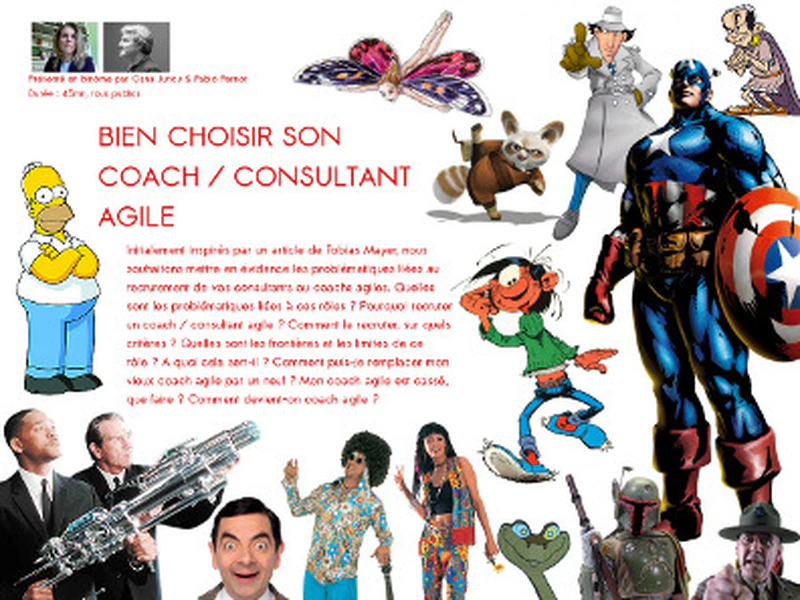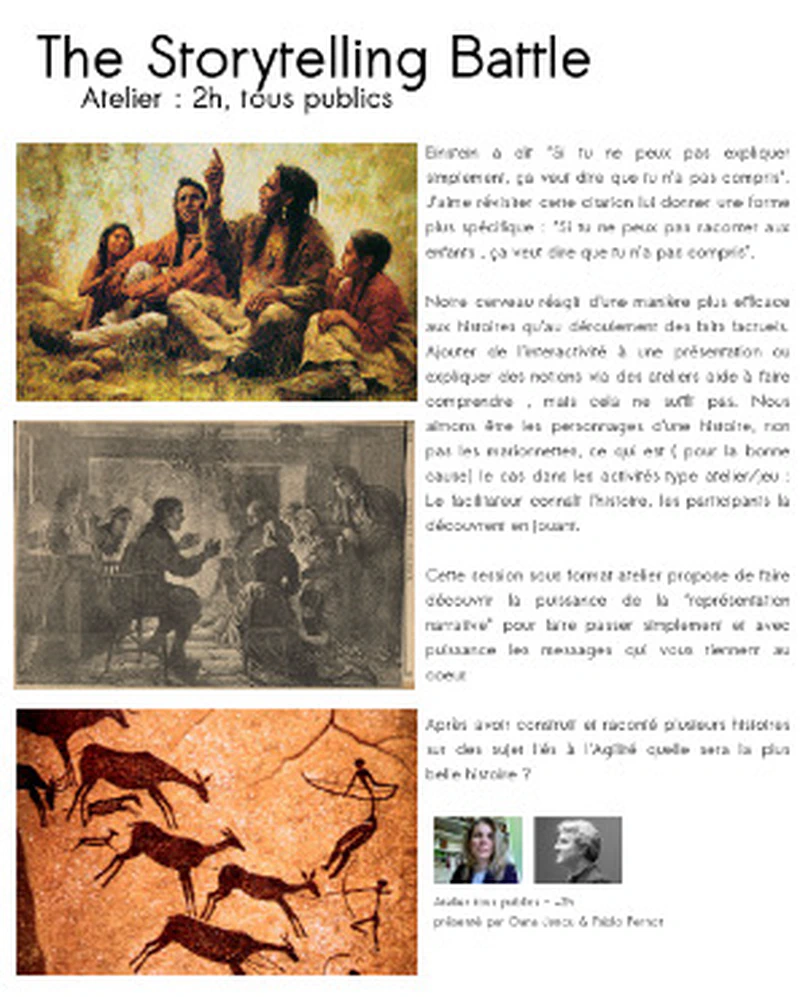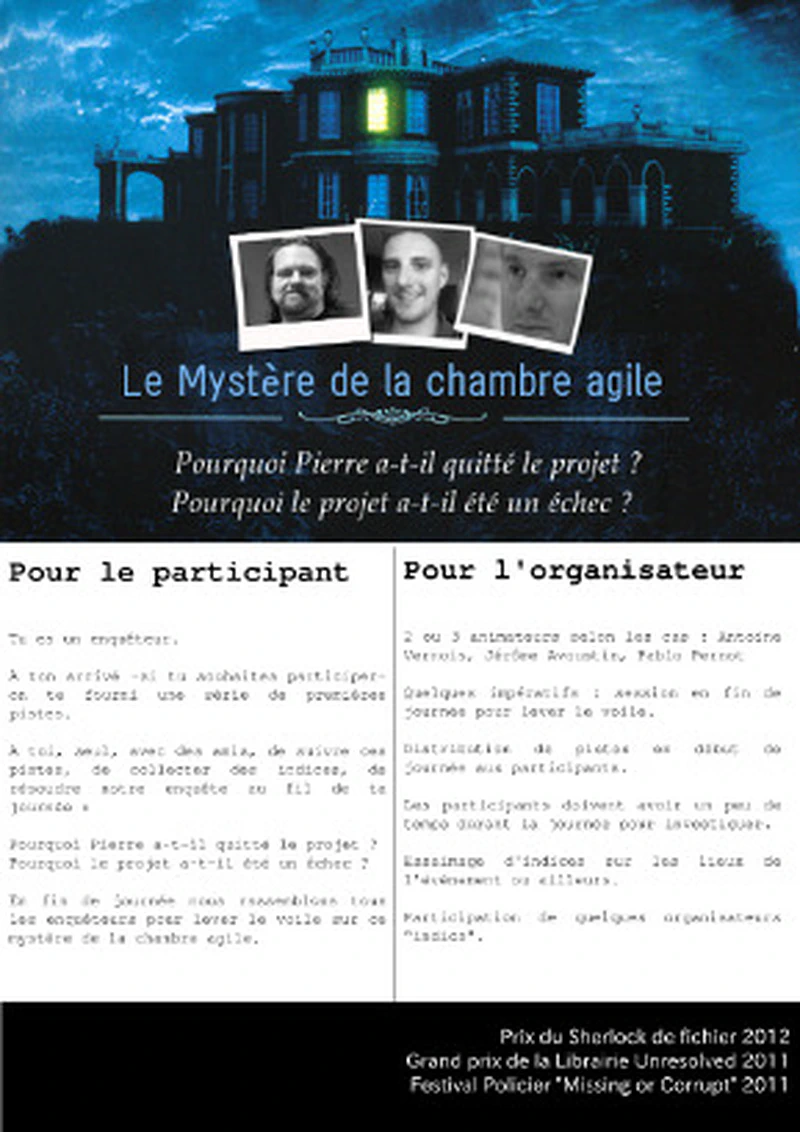It’s the beginning of the year and lacking resolutions (I don’t have any…), I’m exploring a few leads and topics and trying to propose some of them for future conferences or other upcoming events. Here are my 4 first leads and submissions.
But first I want to highlight the pleasure I took in conducting in 2012 sessions with two or three people: the choose-your-own-adventure project with Bruno (then Antoine). And the Product Owner Strategy with Alexis Beuve. In both cases it was a source of additional learning: the constraint related to the other person forces you to better express, define, sell your ideas, but especially the confirmation -once again- of the richness brought by thinking with multiple people. Seeing the content proposed by Bruno or Alexis arrive was a source of pleasure. I worked a lot on both sessions but a sort of lazy joy is born from seeing content spontaneously show up.
Second learning: why do solo sessions, when with two people you introduce rhythm, safety (one person’s oversight is caught by the other), different tones that don’t leave people indifferent? (At the end of Strategy… in Montpellier or Paris I was told this: dialogue is invigorating as a conference format). It was decided to try to repeat the experience in 2013: conferences in pairs.
Product Owner vs Product Manager
The first lead is to create a follow-up to Product Owner Strategy. Take a step back and question the role of Product Manager relative to that of Product Owner. For those who have attended the session (I’ll be sharing in a few days here the filmed session from Montpellier), a vital project for a product owner is not necessarily so for a product manager. How to understand and apprehend these two roles has already been the fruit of discussions between Alexis and me. We discussed the desire to do this session (conference or workshop for that matter), I hope that we will have the opportunity.
Choosing your agile coach / consultant well

Ah ah! There’s no lack of nerve here. “But by what right!” (I can already hear that one). ( click here to get the submission/image in large size ).
I’m thus inaugurating a new pair, hoping to deliver this session with Oana Juncu. Oana and I have often had this discussion between the captain america consultant and their bulldozer approach and the fairy who whispers in their clients’ ears. We’ve wanted to lay out this reflection for a while, 2013 will, I hope, give us the opportunity.
Here’s how we present the session
title:
Choosing your agile coach / consultant well.
summary:
Initially inspired by an article by Tobias Mayer, we want to highlight the good reasons (if there are any..) for hiring your consultants or agile coaches and the journey of teams alongside the coach. The session will address the following questions What are the expectations regarding this role? What is the “healthy” posture? Why hire an agile coach / consultant? How to hire them, on what criteria? What are the boundaries and limits of this role? What is it for? How can I replace my old agile coach with a new one? My agile coach is broken, what to do? How does one become an agile coach?
Objectives and benefits of the session for participants?
Frustrations, preconceived ideas and false pretenses in working as and with an agile coach? If this has happened to you, the session proposes to offer some leads to avoid them if we’re lucky. There is no absolute truth about the posture of an agile coach, the session brings participants to untangle a series of questions: Who are these agile coaches? How does one become an agile coach? What are they for? When should they be brought in? What are the limits of their interventions?
The storytelling battle

This collaboration shouldn’t stop there (I’ll tell you more very soon within the month I hope) and will also take the form of a joint session on a topic dear to Oana’s heart: storytelling. ( click here to get the submission/image in large size ).
I’ll let Oana present this session:
Einstein said “If you can’t explain it simply, it means you haven’t understood it”. I like to revisit this quote and give it a more specific form: “If you can’t tell it to children, it means you haven’t understood it”.
Our brain reacts more effectively to stories than to the unfolding of factual facts. Adding interactivity to a presentation or explaining concepts via workshops helps understanding, but it’s not enough. We like to be the characters in a story, not puppets, which is (for a good cause) the case in workshop/game type activities: The facilitator knows the story, the participants discover it by playing.
This session in workshop format proposes to reveal the power of “narrative representation” to convey simply and powerfully the messages that are dear to your heart.
Finally,
The mystery of the agile room

This is the continuation of a collaboration with Antoine Vernois (who launched the initial idea), a duo joined by Jérôme Avoustin. This is neither a workshop nor a conference, but an investigation throughout your conference day.
( click to get the submission/image in large size ).
I won’t be able to participate but the first submission was launched toward Sudweb 2013!
For the participant
You are an investigator. Upon your arrival -if you wish to participate- you will obtain the first elements of the investigation.. It’s up to you, alone or in a team, to follow these leads, collect clues, follow leads and solve the investigation throughout your day: Why did Pierre leave the project? Why was the project a failure? At the end of the day, all investigators meet during a final session to unravel the threads of the intrigue and lift the veil on the “Mystery of the agile room”
For the organizer
2 or 3 facilitators depending on the case: Antoine Vernois, Jérôme Avoustin, Pablo Pernot. A few requirements: session at the end of the day to lift the veil. Distribution of leads at the beginning of the day to participants. Participants must have a little time during the day to investigate. Dissemination of clues at the event venues or elsewhere. Participation of a few “informant” organizers.